Gpon Network Architecture Diagram:
Gigabit Passive Optical Network (GPON) is a high bandwidth shared fiber access technology. GPON is a point-to-multipoint access mechanism. Its main characteristic is the use of passive splitters in the fiber distribution network, enabling one single feeding fiber from the provider’s central office to serve multiple homes and small businesses. [boxads]
The GPON Optical Line Terminal (OLT) is typically installed in a Central Office (CO), though it could be installed elsewhere. The optical splitter is installed somewhere between the CO and the subscribers. And a GPON Optical Network Terminal (ONT) is installed at each subscriber’s home. Voice, video, and data traffic must all be delivered across the single GPON downstream wavelength. A nice facet of GPON for IP video support is that its downstream is naturally a broadcast medium, and it is very efficient for delivering multicast traffic.
Gpon Network Architecture Diagram:

The following diagram shows the architecture of a basic two wavelength GPON network architecture, which is probably the most common implementation. The downstream wavelength is 1490nm and transmits data at 2.488 Gbps. The upstream wavelength is 1310nm and transmits data at 1.244 Gbps.
GPON has a downstream capacity of 2.488 Gbps and upstream capacity of 1.244 Gbps that is shared among users. Encryption is used to keep each user’s data secured and private from other users. Although there are other technologies that could provide fiber to the home, passive optical networks (PONs) like GPON are generally considered the strongest candidate for widespread deployments.
[bodyads]
Gpon provides Triple play services over IP of video, data and voice are often cited as driving user demand for heavier usage of broadband that justifies PON investment. While RF overlay has been popular in some countries and minimizes congestion caused by usage of video services, the convergence of HDTV and IPTV, and the growth in internet cloud services could create demand for bandwidth that exceeds the capacity of gigabit services in future. Teleworking and video conferencing are other applications demanding such triple play capabilities.
In future Gpon bring 10-Gigabit-capable passive optical network that is called XG-PON, thats downstream capacity 10 Gbit/s and upstream capacity 2.5 Gbit/s (nominal line rate of 9.95328 Gbit/s downstream and 2.48832 Gbit/s upstream).
The 10 Gigabit PON wavelengths is (1577 nm down / 1270 nm up) that’s differ from GPON and EPON (1490 nm down /1310 nm up), allowing it to coexist on the same fibre with either of the Gigabit PONs.

